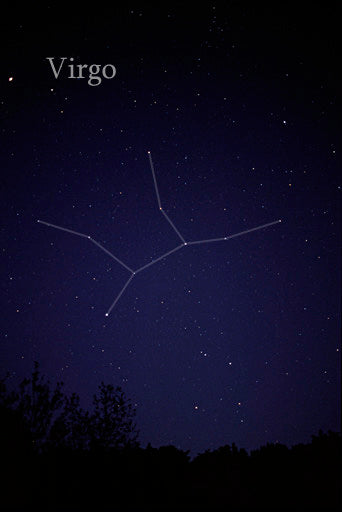All About The Virgo Constellation
Virgo constellation is one of the oldest constellations in the sky. During the September equinox, the sun passes over the Virgo constellation. The full September moon is considered the harvest moon which is why the constellation is strongly linked to harvest season. It is also the second-largest constellation, covering about 1,294 square degrees.
Virgo, in Latin means “virgin.” It is one of the 48 constellations first cataloged by the Greek astronomer Ptolemy in the Almagest during the second century.
The Virgo constellation has been a fascination for astronomers for centuries. The constellation is rich in galaxies and there is a huge galaxy cluster (Virgo Cluster) within Virgo’s boundaries that calls for exploration. There is also a history of two meteor showers associated with the constellation, the Virginids and the Mu Virginids.
How to find Virgo Constellation
Virgo constellation is located in the 3rd quadrant of the southern hemisphere. The coordinates of the constellation are 13h 00m 00s, +00° 00′ 00” and can be seen at latitudes between +80° and -80°.
The constellation lies at the curve of the Big Dipper/Plough and Boötes. On the west is the Leo constellation and Libra on the east.
Virgo can be spotted in the spring sky in the northern hemisphere during March and April, and in the autumn sky during the southern hemisphere.

By Till Credner - Own work: AlltheSky.com
Mythology
Virgo’s mythology dates back to the Greek’s harvesting season during spring. It was the time of peace, prosperity and happiness, the food grew in ample amounts and men lived grandly. Dike, the goddess of justice instilled wisdom and justice among the people. She is depicted in the constellation as a woman with angelic wings, holding an ear of wheat grain in her left hand. This hand also refers to the brightest star of the constellation, Spica.
In another similar theme, the daughter of Zeus was abducted by Hades. Her mother retaliated by ruining the harvests which resulted in infertility and famine. Later on, the daughter was released and the mother allowed harvests to regrow again.
In Babylonian Mythology, the constellation is associated with fertility. A part of the constellation was called “The Furrow,” referring to the Sumerian goddess of grain called Shala.
NAME A REAL STAR NOW!
Give a Star from a Constellation the name of your choice! With a Star Naming you will make an unforgettable gift for eternity. Save 10% on your first order with the coupon code: GALAXY10
NAME A STAR NOWMajor Stars of Virgo Constellation
The Virgo constellation has 15 main stars, 96 Bayer/Flamsteed stars and 29 stars with planets. Here are some of the famous stars in the constellation.
Spica (α Virginis)
Spica is one of the brightest stars in the Virgo constellation and the 15th brightest star in the night sky. It is a blue-white star located about 250 light years away from the Sun.
Spica is easily visible in clear skies and even in light polluted areas. Its brightness comes from its large size and close proximity to Earth.
The name Spica originates from Latin, meaning “the virgin's ear of grain” which refers to the wheat grain the goddess of Justice, Dike, holds in her hand in the constellation. It is also called “sunbulah” in Arabic, meaning “ ear of the grain.”
Zavijava (β Virginis)
Zavijava or Beta Virginis is a beta star, located 35 light years from the Earth. It has an apparent visual magnitude of 3.604 and absolute magnitude of 3.41.
Zavijava is about 2.8 and 4.7 billion years old and has a radius 1.65 times that of the Sun. The star is thought to be more metal-rich than the Sun, with possible high presence of elements heavier than helium.
Porrima (γ Virginis)
Porrima is derived from Ancient Rome and refers to the goddess of prophecy. The Chinese name of the star is ài Wēi Zuǒ Yuán èr, meaning “second star of left wall of supreme palace enclosure.”
It is located near the celestial equator and is difficult to be spotted in the night sky. The star system i39 light years away from the Sun.
It is a binary star located at 2.8 degrees north of the ecliptic. This means that the star can be occulted by the Moon and not by the planets.
Auva (δ Virginis)
Delta Virginis is located 198 light years from the Sun. It has an apparent visual magnitude of 3.4 and an absolute magnitude of –2.4 which makes it bright enough to be visible with a naked eye.
The star’s radius is 48 times that of the Sun and it is 468 times brighter compared to the Sun’s. It comes from evolved stars called red giants which is why the star has an orange-red glow.
Vindemiatrix (ε Virginis)
Epsilon Viginis or Vindemiatrix is the third-brightest star of the Virgo constellation. It is located at a distance of 109.6 light years from the Sun. The star is also 2.6 times bigger than the Sun. Vindemiatrix can be spotted as a yellow-hued star visible in a clear night sky.
The name Vindemiatrix is derived from Greek, meaning “the grape-harvestress.” In Chinese, Epsilon Virginis is called Tài Wēi Zuǒ Yuán sì, meaning “the fourth star of left wall of supreme palace enclosure.”
EVERYTHING ABOUT THE Virgo
- Profession & Career
- Love & Partnership
- The Virgo Man
- The Virgo Woman
- Virgo Constellation
THE PARTNERS OF Virgo
- Virgo & Aquarius
- Virgo & Pisces
- Virgo & Aries
- Virgo & Taurus
- Virgo & Gemini
- Virgo & Cancer
- Virgo & Leo
- Virgo & Virgo
- Virgo & Libra
- Virgo & Scorpio
- Virgo & Sagittarius
- Virgo & Capricorn
- Zodiac Sign Aquarius
- Zodiac Sign Pisces
- Zodiac Sign Aries
- Zodiac Sign Taurus
- Zodiac Sign Gemini
- Zodiac Sign Cancer
- Zodiac Sign Leo
- Zodiac Sign Virgo
- Zodiac Sign Libra
- Zodiac Sign Scorpio
- Zodiac Sign Sagittarius
- Zodiac Sign Capricorn
